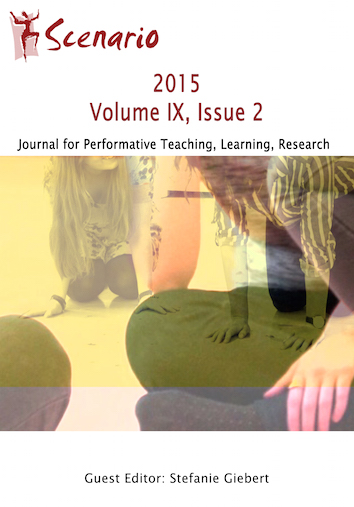Motion and emotion on the language learning stage
DOI:
https://doi.org/10.33178/scenario.9.2.6Abstract
Growing numbers of teachers and students practicing theatre and drama techniques to boost language learning are convinced of the usefulness for the language learning process of improvising or enacting a script, of reinterpreting or faithfully performing a piece of literary drama. The latest findings in the field of neurosciences give a new and robust scaffolding to teachers’ general belief that drama activities boost language learning.It is argued that such expectations are well-rooted in language teaching methodology and that drama, theatre and the performing arts in general do offer a peculiar combination of benefits to foreign and second language learning, as exemplified by: 1) a paradigmatic case of cooperative learning, with naturally inbuilt roles; 2) an authentic reason for repetition and memorization, enriching rote with meaning and expression.Evidence resulting from neuroimaging research and developments of the discovery of mirror neurons and consequent hypotheses about the evolutionary path to the development of verbal language are reviewed to show ’hard science’ support to the beliefs gathered through praxis by teachers and students and to direct a specific focus on (the need for) the connection of body, voice, motion and emotion in (language) learning.Literaturhinweise
Baron-Cohen, Simon (1995): Mindblindness: An Essay on Autism and Theory of the Mind. Cambridge, MA: MIT Press
Bastiaansen, Jojanneke C. J.; Thioux, Marc & Keysers, Christian (2009): Evidence for Mirror Systems in Emotions. In: Philosophical Transactions: Biological Sciences 364/1528, Evolution, Development and Intentional Control of Imitation (August), 2391-2404
Beard, Colin; Clegg, Sue & Smith, Karen (2007): Acknowledging the Affective in Higher Education. In: British Educational Research Journal 33/2 (April), 235-252
Cook, Amy (2007): Interplay: The Method and Potential of a Cognitive Scientific Approach to Theatre. In: Theatre Journal 59/4, Performance and Cognition (December), 579-594
Coppola, Antonietta; Giuli Graziella & Invernizzi Franca (1997): Chi ha paura del lavoro di gruppo? Attività in cooperazione per apprendere le lingue straniere. Firenze: La Nuova Italia
Corballis, Michael C. (2003): From Hand to Mouth: The Origins of Language. Princeton, NJ: Princeton University Press
Dulay, Heidi & Burt, Marina (1977): Remarks on Creativity in Language Acquisition. In: Burt, Marina; Dulay, Heidi & Finocchiaro, Mary (eds.): Viewpoints on English as a Second Language. New York: Regents
Ferrari, Pier Francesco; Gallese, Vittorio; Rizzolatti, Giacomo & Fogassi, Leonardo (2003): Mirror neurons responding to the observation of ingestive and communicative mouth actions in the monkey ventral premotor cortex. In: European Journal of Neuroscience 17, 1703-1714
Fogassi, Leonardo & Ferrari, Pier Francesco (2007): Mirror Neurons and the Evolution of Embodied Language. In: Current Directions in Psychological Science 16/3 (June), 136-141
Gentilucci, Maurizio & Corballis, Michel C. (2006): From manual gesture to speech: A gradual transition. In: Neuroscience and Biobehavioral Reviews 30, 949–960
Hasselmo, Michael E.; Rolls, Edmund T.; Baylis Gordon C. & Nalwa, Vanit (1989): Object-Centered Encoding by Face-Selective Neurons in the Cortex of the Superior Temporal Sulcus of the Monkey. In: Experimental Brain Research 3, 179-186
Krashen, Stephen D. (1982): Principles and Practice in Second Language Acquisition. Oxford, UK/Elmsford, NY: Pergamon Press
Iacoboni, Marco; Molnar-Slakacs, Istvan; Gallese, Vittorio; Buccino, Giovanni; Mazziotta, John C. & Rizzolatti, Giacomo (2005): Grasping the intentions of others with one own’s neuron mirror system. In: PLoS Biology 3, 529-535
Larsen-Freeman, Diane & Anderson, Marti (2011): Techniques & Principles in Language Teaching. Oxford: Oxford University Press
Lecoq, Jacques [in collaboration with]; Carasso. Jean-Gabriel & Lallias, Jean-Claude (1997): Le Corps poétique, un enseignement de la création théâtrale. Anrat: Actes Sud – Papiers
Lozanov, Georgi (1978): Suggestology and Outlines of Suggestopedy. Philadelphia, PA: Gordon & Breach
Lozanov, Georgi & Gateva, Evelyna (1988): The Foreign Language Teacher's Suggestopedic Manual. New York: Gordon & Breach
Meini, Cristina (2007): Psicologi per natura. Introduzione ai meccanismi cognitivi della psicologia ingenua. Roma: Carocci
Rizzolatti, Giacomo & Sinigaglia, Corrado (2007): Mirrors in the Brain: How Our Minds Share Actions, Emotions, and Experience (transl. Frances Anderson). Oxford: Oxford University Press
Rizzolatti, Giacomo & Sinigaglia, Corrado (2006): So quel che fai. Il cervello che agisce e i neuroni specchio. Milano: Raffaello Cortina
Reinhardt, Michaela (2010): Theater im universitären Sprachunterricht.„Alte Methoden“ im besonderen Kontext. In: Daf-Werkstatt. Halbjahrszeitschrift für die Didaktik der Deutschen Sprache an der Universität Siena 15-16, 87-96
Schippers, Marleen B.; Roebroeck, Alard; Renken, Remco; Nanetti, Luca; Keysers, Christian; Hari, Riitta (2010): Mapping the information flow from one brain to another during gestural communication. In: Proceedings of the National Academy of Sciences of the United States of America 107/20 (May), 9388-9393
Solinas, Letizia (2013): L'apprendimento delle lingue in scena. Unpublished B.A. thesis. Vercelli: Dipartimento di Studi Umanistici
Steele, James; Ferrari, Pier Francesco & Fogassi, Leonardo (2012): From action to language: comparative perspectives on primate tool use, gesture and the evolution of human language. In: The Philosophical Transactions of the Royal Society B 367, Special Issue (January), 4-9
Von Rhoneck, Mayring; Von Rhoneck, Philip & Von Rhoneck, Christoph (eds.) (2003): Learning Emotions: The Influence of Affective Factors on Classroom Learning. Frankfurt a. M.: Peter Lang
Downloads
Veröffentlicht
Ausgabe
Rubrik
Lizenz
Copyright (c) 2015 the author(s)

Dieses Werk steht unter der Lizenz Creative Commons Namensnennung - Nicht-kommerziell - Keine Bearbeitungen 4.0 International.







